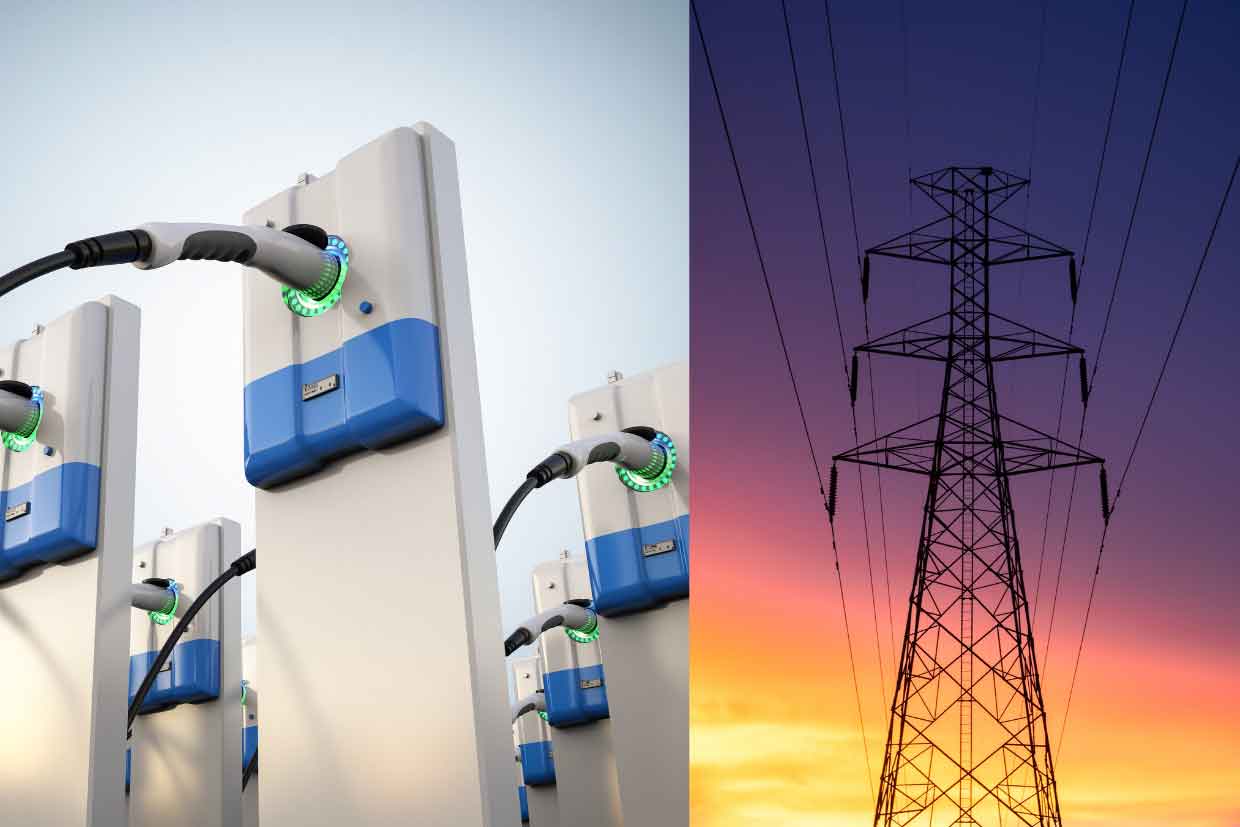Vehicle-to-grid, also known as V2G, technology is smart charging equipment that allows automobile batteries to feed back to the power system. In effect, these high-capacity batteries could not only be used to power EVs, but to backup storage cells for the electrical grid as well.
These systems use bidirectional charging stations to push and draw energy to and from linked vehicles based on the demand for electricity. It’s part of what is known as vehicle-grid integration. This additional energy can be used in buildings and ultimately anything connected to the electrical system.
In order to be of assistance to the grid, the V2G performs two primary functions namely valley filling and peak shaving.
- The ability of electric automobiles to only charge during periods of low demand, typically overnight, is referred to as “valley filling.”
- When an electric vehicle delivers power back into the grid during peak hours, the practice is known as “peak shaving.” This helps to balance off the enormous load that is placed on the system.
There are a few subcategories of V2G that are now being tested and deployed around the world. These include the technologies known as V2H, V2B, and V2X.
Vehicle-to-Home
The term “vehicle-to-home” technology refers to the capability of an electric car to function as a domestic backup power source in the event that the electricity goes out. Alternately, V2H can also be utilized on a regular basis as a renewable energy source, which will both lower your energy expenditures and decrease your reliance on the grid. Electric vehicles have the capability of capturing solar energy and storing it.
Vehicle-to-Building
Vehicle-to-building technology performs the same function as vehicle-to-home (V2H) technology, but on a more extensive scale for commercial and industrial structures. One example is that a firm might have a fleet of electric cars, but not all of them might be in operation at any given time. During the time that they are at the EV charging station, they have the opportunity to either augment the building’s power use or even balance it out, thus lowering the building’s overall energy expenditures. In the United States, this is currently being put through extensive testing.
Spare batteries and vehicle to grid energy services
When we think of an electric vehicle (EV), we might picture a car plugging itself into the electrical power grid in order to charge up before setting out on its journey. Along the road, its battery will run out of power, and when that happens, it will require another charge from being plugged in. To put it another way, the interaction between the grid and the EV is unidirectional and the grid provides the EV with the electricity it needs so that it may be driven.
This process is bi-directional. What if electric vehicles, when plugged in and parked, were able to connect with the grid and serve as a backup battery? They would not only get power to charge their devices, but they would also give some of it back. Yes, it is possible.
Most of the vehicle owners only use a small portion of the capacity of their batteries, which indicates that there is a significant quantity of unused energy that is being stored that may be put to use in other ways. Services including but not limited to supporting local energy distribution utilities and minimizing the intermittent nature of renewable energy sources are examples of these types of services.
In the beginning, Vehicle to Grid will more accurately be referred to as Grid to Vehicle. An inverter is able to send electricity from the car back onto the grid when there is a demand for it and when the owner is ready to do so. This occurs when the battery is fully charged. You are able to set limitations on how much charge can be pulled at one time. It will ensure that your battery is never completely discharged.
Vehicle to Grid Technology and its implementation
Although the V2G technology has been put into use in a number of countries throughout the globe, in the majority of these locations, it is still mostly considered a theoretical answer including the United States of America. In the next few years, we should see widespread acceptance of V2G if we conduct additional testing and if state and municipal governments cooperate and provide funds for its development.
What are the vehicles that are compatible with Vehicle to Grid Technology?
At the moment of writing, there are no electric vehicles in the United States that are capable of V2G. The vast majority of electric vehicles are capable of V1G. V1G is also known as unidirectional smart charging. The Tesla Model 3 and the BMW i3, and a great many more electric vehicles are all capable of being charged via smart charging.
The Nissan LEAF electric vehicle has been the subject of the majority of testing with regard to the adoption of vehicle-to-grid technology. But, residential Nissan LEAF owners in the United States do not currently have access to the V2G feature.
Around the LEAF, other countries are constructing their own V2G systems, and the French energy firm EDF is an example. The company is collaborating with Nissan to develop a V2G system for electric cars. If they succeed, it will presumably reduce the overall cost of energy for these enterprises.
In the United States, Tesla markets and sells the Powerwall, a backup power system that performs a function analogous to that performed by V2H technology. The solar energy that is generated by a house is stored in these battery banks, which allow the house to continue functioning normally even when the power is out. But, it does not yet integrate with the enormous features that are present in each and every Tesla EV; nevertheless, this may become a new feature in the near future.
Enhancing Capabilities of the Smart Grid
The creation and distribution of smart grid technologies is currently one of the most exciting new areas of research and development in the electrical engineering industry. Smart grid technology can change how power is delivered to electricity consumers and the technology itself is environmentally friendly. This potential is backed by the growing demand around the world for options that are green and fuels that are alternatives.
Benefits of Vehicle to Grid Technology
-
Batteries that are used by the grid
Every person who drives an electric vehicle has the potential to become a supplier of energy. It is because of the fact that while the vehicle is being charged, its battery will function as an energy storage facility that is connected to the grid.
That will make it possible for the grid to become more efficient, which will increase people’s own electricity consumption and optimize the way energy is produced and consumed on a local level. V2G will mean that people who drive electric vehicles could also receive economic benefits for the services they provide.
-
Cost-effective
Businesses that operate electric car fleets can realize significant cost savings while simultaneously supporting environmentally conscious business practices. The vast majority of cars in a fleet are only used during regular work hours. These electric automobiles may be linked into the system to assist in balancing the loads on the region’s power grid during peak hours as they are not being used on certain days.
-
It increases the capacity for the storage of renewable energy.
Renewable sources of energy, such as solar, are absolutely necessary to the operation of a sustainable economy. These sources are both sporadic and unpredictable. The ability to collect energy from these sources when it is available and store it so that it may be distributed when it is required is essential to the operation of a reliable power grid.
Existing systems are able to store renewable energy as it is generated; however, if there is a sudden increase in the amount of energy, such as when there are heavy winds, the capacity of the system’s storage could be exceeded, resulting in a loss of precious energy. Increasing the storage capacity of electric vehicles by connecting their batteries creates additional room to store this important energy.
Hindrances for the implementation of vehicle grid technology
Despite these advantages, there is still a significant amount of work to be done before we can implement a secure bidirectional electric vehicle charging system.
- The majority of currently available automobiles and charging stations are unidirectional. This mean that the conversion process will require significant financial expenditure.
- When it comes to putting V2G into practice, one of the most difficult obstacles is the infrastructure that it interacts with. It is difficult for automobiles to properly push energy back into the electric grid since, in many areas, there is inadequate existing infrastructure, and the circumstances of the system at the moment are already problematic.
- Although the increased use of renewable sources to generate electricity is excellent news for the environment, there is a risk that this trend may lead to system instability. For instance, solar and wind power might vary depending on the circumstances of the surrounding atmosphere. It is anticipated that by the year 2050, renewable sources would account for 62 percent of the energy that is generated, which will result in increased grid volatility and unpredictable demand. V2G actually has the potential to make a difference in reducing the impact of this issue.
- In addition, there is no uniform set of regulations for the integration of vehicles into the grid. Because of this, implementing such technologies across the country is tough.
Conclusion
The development of vehicle-to-grid, or V2G, technology was spurred forward by the proliferation of electric vehicles and the rise of the smart grid. Imagine that a natural disaster has knocked out your power supply and you have to run your house on the juice from your electric car. Even though your car might not be able to power your entire home, it still has the potential to provide you with enough power to charge your phone, or keep the refrigerator running. This is possible with the utilization of vehicle-to-grid technologies.
We are thrilled to see where this project will go in the future and are encouraged by the support and creativity that is surrounding the technology that connects vehicles to the grid. In conjunction with several other energy-related projects, Vehicle-to-Grid (V2G) has the potential to play a significant part in the stabilization of the deteriorating power grid that is still affecting the whole world. In addition, the technology may be of assistance in the transition that the nation is making toward the broad use of electric vehicles and renewable sources of energy.


